Application of Student Centered Learning (SCL) Method through Discovery Strategies in Vocational Educations ()
1. Introduction
In general, vocational education aims to prepare students to become members of society who have the ability of professional experts to apply, develop and disseminate technology, and strive to use it to improve people’s lives and enrich national culture. Specially, vocational education is directed to produce graduates who have mastered skills in the field of work and are good at speaking, so that they can be directly absorbed as workers in each industry, government institution or self-employment; this is because the teaching load in the vocational education program has been compiled into skills courses (Polii, 2015; Samponu, Wauran, & Tampangela, 2017).
Vocational education, in this case the education at the Manado State Polytechnic, is a campus oriented in the field of expertise, where the graduates are students who get applied diplomas. Graduating with a degree of expertise, professional certification, and internship experience makes it often used as a green light for companies or governments in recruiting graduates majoring in vocational studies (Samponu, Wauran, & Tampangela, 2017). Vocational education, in this case at the Manado State Polytechnic Business Administration Department, is to graduate students who have the skills and expertise, and are good at speaking to express many opinions (Samponu, Wauran, & Tampangela, 2017).
The reason the researchers chose this title was that researchers wanted to direct students to master the ability in the field of work as workers in industry, government or private institutions and self-employment. With the direction of educators, students will also get new technology themselves. The problem in this study is because the learning system that has been carried out so far is the conventional learning system (faculty teaching), or ordinary learning (Agustina, Saputro et al., 2015).
With this background, this study intends to shift the paradigm to the Student Centered Learning (SCL) method through discovery strategies.
This Student Centered Learning (SCL) method is present as an antithesis to conventional methods. Another reason, so far, still using conventional learning systems or ordinary learning, is that they are less flexible in accommodating learning developments because educators have to intensively adjust theory with the latest technological developments (Haryono, 2017).
In this research, researchers have created a Student Centered Learning (SCL) method through a discovery strategy. The discovery method is a teaching method that regulates teaching in such a way that students acquire previously unknown knowledge not through notification, partially or completely discovered (Arief, 2012; Sari, Jamil et al., 2016). The purpose of this study: 1) To create and test the Students Centered Learning approach method through discovery strategy. 2) Developing student-centered learning methods to foster independent learning. 3) To determine the findings through the Students Centered Learning Method. 4) To find out that the learning outcomes using the SCL approach through discovery strategies are better than conventional learning or ordinary learning. Benefits of research: As an effort to improve learning outcomes and increase understanding and the active role of students in the classroom. With the Students Centered Learning method, it can provide high motivation for students. The results of this study are expected to be used as an effort to improve and increase the quality of learning.
This Student Centered Learning method is made in a group and this research is in accordance with the Manado State Polytechnic research strategic plan to support learning methods in the field of technology. Our research team consists of 3 people, the head researcher, member 1 and member 2. The task of the chairman is to create the Students Centered Learning method through discovery strategies and together with member 1 has conducted (tested) this method in learning in classes. The task member 2 have evaluated and collected data. After the data was collected, our research team processed the data together, to obtain learning outcomes from the Students Centered Learning Method through a discovery strategy.
2. Literature Study
2.1. Student Centered Learning (SCL) Method
Small Group Discussion tutorials that make students go to the stage of looking for references, complete “learning objectives” and understand the reference materials they have obtained. Collaborative Learning is approach used for teaching and learning that involves a group of students working together to solve problems, complete assignments or produce products.
Self Directed Learning is a constructivist learning model that is centered on students (student centered). This SDL model is based on the view of John Dewey that every individual has unlimited potential to grow and develop. Contextual Instruction is the concept of learning that helps lecturers relate course content to real situations in everyday life and motivates students to make connections between knowledge and its application in everyday life as members of society, professional or managerial workers, entrepreneurs, and investors. Project Based Learning is innovative student-centered learning and places educators as motivators and facilitators, where students are given the opportunity to work autonomously and construct their learning. Problem Based Learning and Inquiry is a problem-based learning that will lead students to real problem situations. Real problems are needed in the learning process to improve students’ learning abilities (Nuz’miah, 2016).
Student Centered Learning (SCL) is a learning model that is currently popular in the world of education, which itself means a student-centered learning process. According to UU (law) number 20 of 2003 concerning the National Education System and Law of the Republic of Indonesia number 13 of 2012 concerning higher education, it is stated that learning is the interaction between educators, students and learning resources in a particular learning environment (Haryono, 2017).
2.2. Strategy Discovery Steps
The concepts or principles that students must discover through these activities need to be written clearly. Tools or materials need to be provided in accordance with the needs of students in carrying out activities. The discussion as a direction before students carries out activities. The critical thinking process needs to be explained to show the operational mentality of students, which is expected in student activities. It is necessary to develop open questions, which lead to the activities carried out by students. There are educator notes that include explanations of difficult issues and factors that could affect the results, especially if the investigation failed or did not work properly.
According to Bruner, learning is best when students discover information and concepts on their own. In discovery learning, students use inductive reasoning to derive principles and examples. Bruner believes that students can have knowledge if they find themselves and are responsible for their own learning activities, which motivate them to learn (Setiarini, 2016).
2.3. Vocational Education
Student Centered Learning (SCL) in Vocational Education takes the Student Centered Learning (SCL) method and through discovery strategies, so that students can find results, new ideas and technological result in one method that are also proficient in speaking. With this method, it can fulfill the Institutional Strategic Plan in the learning process that produces one method (Prassida & Muklason, 2012).
3. Research Methods
3.1. Method
This research is a classroom action research. While the approach used in this research is qualitative research. The research location is located at Manado State Polytechnic, Business Administration Department. Data collection techniques, namely observation and using documents research questionnaire. Data analysis technique is the process of arranging data sequence and organizing it into a pattern.
3.2. SCL Products/Applications through the Discovery Strategy
1) Start Menu
Contains the title of the application (red circle) and a button to start (START button).

2) Main Menu
Contains the main menu of the application. Numbers 1 to 4 are a button to access one of the 4 chapters. Number 5 is the access button to the about menu, and number 6 is the button to exit.
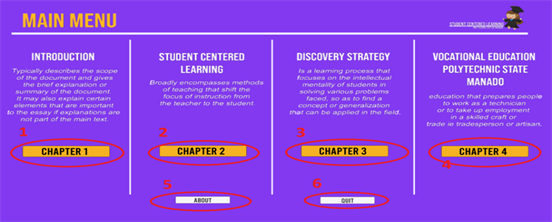
3) Chapter 1: Introduction
Contains an introduction to the material and an introduction to the Student Centered Learning application (There is a BACK button to return to the main manu).
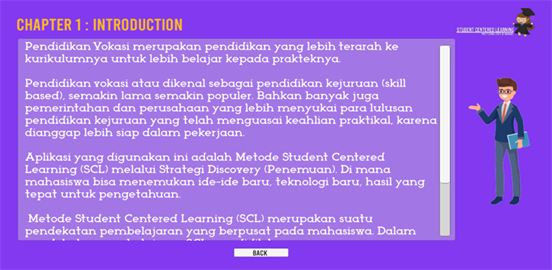
4) Chapter 2: Student Centered Learning
Contains Student Centered Learning material (There is a BACK button to return to the main manu).
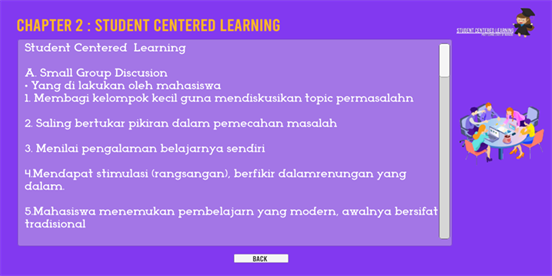
5) Chapter 3: Discovery Strategy
Contains theory from Discovery Strategy (There is a BACK button to return to the main manu).

6) Chapter 4: Vocational Education Polytechnic State of Manado
Contains the vision and mission of Manado State Polytechnic (There is a BACK button to return to the main menu).
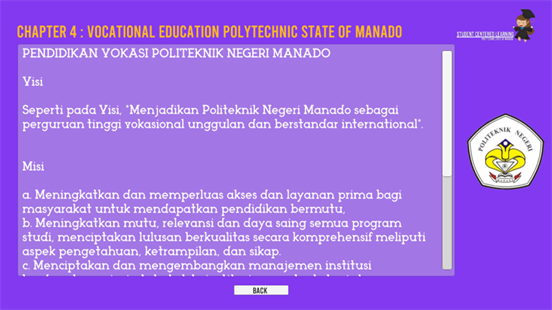
7) About
Contains the name of the application maker, the engine used in making the application, and the copyright of this application (There is a BACK button to return to the main manu).
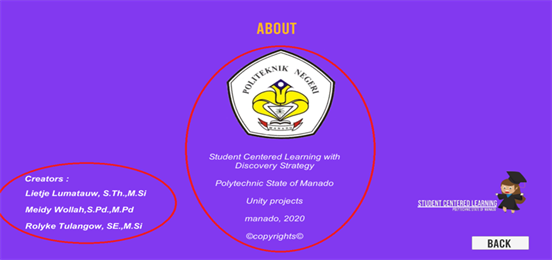
3.3. Flowchart Application
Flowchart is a schematic or chart that describes the sequence of activities from one program from the beginning to the end. The purpose of a flowchart is to know the workflow of a program when the program is running.
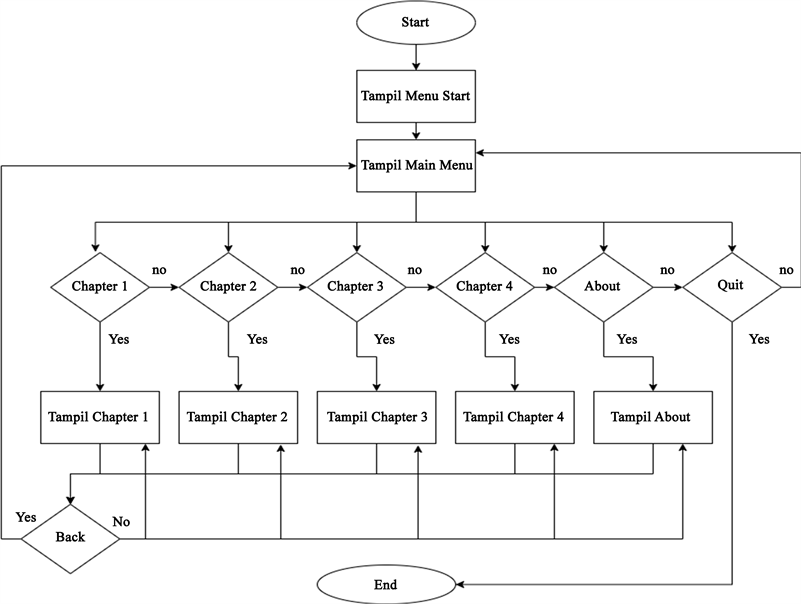
4. Results and Discussion
Correlation Analysis Results
In this table, the partial correlation analysis results are presented to find out the relationship between each variable in this study: Student Centered Learning as the first variable (V1), Discovery Strategy as the second variable (V2), and Manado State Polytechnic Vocational Education as the third variable (V3).
Table 1 explains that the correlation or relationship between the Student Centered Learning variable and the Discovery Strategy variable is 0.825 or in other words, the Student Centered Learning variable and the Discovery Strategy variable have a very strong relationship. While the correlation between the Student Centered Learning variable and the Manado State Polytechnic Vocational Education variable is 0.622 or in other words, the Student Centered Learning variable and the Manado State Polytechnic Vocational Education variable have a
![]()
Table 1. Correlations analysis result.
strong relationship. Likewise, the correlation between the Discovery Strategy variable and the Manado State Polytechnic Vocational Education variable is 0.733 or in other words, the Discovery Strategy variable and the Manado State Polytechnic Vocational Education variable have a strong relationship. Table 1 also shows that the calculation of the correlation has been significant, it can be seen in the significance value of 0.05 where all the Sig values between variables are below the value of 0.05 so it can be said that all the results of the correlation calculations are significant.
5. Conclusion
Student Centered Learning (SCL), is learning that is more emphasized on student activity. The purpose of the Student Centered Learning (SCL) model through discovery itself is to improve the quality of learning carried out by educators, optimally develop student potential in teaching and learning activities, and is a discovery in a mental process which expects students to assimilate a concept or a principle. Therefore Student Centered Learning (SCL) through discovery is an appropriate learning method. This is very useful in vocational education, in this case vocational education at Manado State Polytechnic, Business Administration Department. With the results of Student Centered Learning and the Discovery Strategy variable of 0.825 or in other words, there is a very strong relationship. While the correlation between the Student Centered Learning variable and the Manado State Polytechnic Vocational Education variable is 0.622 or in other words, there is a strong relationship. Likewise, the correlation between the Discovery Strategy variable and the Manado State Polytechnic Vocational Education variable is 0.733 or in other words there is a strong relationship. Student Centered Learning has the potential to encourage students to learn more actively, according to the style, pace and rhythm of each individual learning. And also the rhythm of learning needs to be guided so that it continues to be dynamic and has a high level of competence, with this research, in order to be useful for lecturers, students and society.